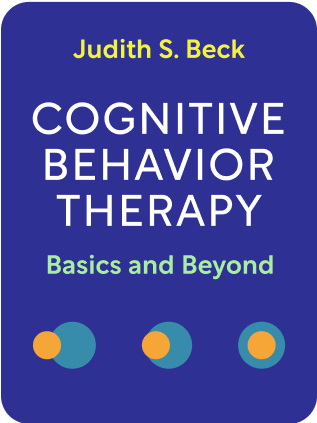

This article is an excerpt from the Shortform book guide to "Cognitive Behavior Therapy: Basics and Beyond" by Judith S. Beck. Shortform has the world's best summaries and analyses of books you should be reading.
Like this article? Sign up for a free trial here .
What is a typical CBT session structure? How does having a clear structure help your patient?
Having a regular CBT session structure ensures that the patient and therapist are on the same page and both know what to expect. Each session should follow a clear structure made up of tasks such as identifying problems, setting goals, and assigning homework.
Keep reading to find outlines of exemplary CBT session structures.
CBT Session Structure: Types of Sessions
In Cognitive Behavior Therapy: Basics and Beyond, psychologist Judith Beck outlines ideal CBT session structures.
Each CBT session structure consists of regular activities. Here we’ll go over the CBT session structure for three types of sessions:
- The evaluation session, which aims to build a cognitive conceptualization of the patient
- The first therapy session, where treatment and problem-solving will begin
- Each therapy session afterward, where treatment continues and the patient progresses toward self-sufficiency
The CBT session structures will refer to tasks such as problem-solving, identifying beliefs, and assigning homework.
The Evaluation Session
The goal in the evaluation session is to start building a cognitive conceptualization of the patient. Treatment and problem-solving should NOT be done until the first therapy session.
Prepare by gathering all the notes available, including previous psychiatry work.
- Check that the patient has had a recent medical check-up—an organic issue like hypothyroidism may be misdiagnosed as depression.
Invite a family member or friend to attend, but start the meeting alone with the patient and discuss when to bring the other person in on the session.
Set the agenda and convey expectations for the session.
- “This is an evaluation session. I’ll ask a lot of questions to determine the diagnosis. A number of questions may not be relevant. Is that OK?”
- “I’d like to find out about symptoms you’ve been experiencing and how you’ve been functioning lately. I’ll ask you to tell me anything else you think I should know. Then we’ll set broad goals, I’ll share initial impressions, and what we should focus on in treatment. At the end I’ll see whether you have other questions. Does that sound OK?”
- “Is there anything else you want to cover today?”
Conduct the assessment.
- Get a full medical and social history.
- Ask patients to describe their typical day. Look for variations in mood; how they interact with other people; how they function at home and work; how they spend free time.
- Pinpoint difficulties in their daily life to address (for example, difficulty sleeping, social isolation, limited opportunities for mastery, or falling behind in schoolwork).
- Ask about positive experiences (“what are the better parts of the day?”)
- Ask about coping strategies (“even though you were tired, how did you get yourself to go to class?”)
- Structure the questions to get what you need: “For these next questions, I just need a yes or no.”
- End with: “Is there anything you’re reluctant to tell me? You don’t have to tell me what it is. I just need to know if there’s more to tell.”
Discuss bringing the guest into the session, and ask if there’s anything the patient wants to guard from the guest.
- Ask the guest what is most important for you to know.
- If the guest focuses on the negative, ask about the patients’ positive qualities and strengths.
Relate your impressions.
- “I’ll need time to review my notes to establish the diagnosis. But my impressions so far are [these].”
Set initial broad goals.
- “We’ll set more specific goals, but broadly should we say our goals are: reduce depression, do better at school, get back to socializing?”
- “In the future we’ll find problems to solve and engage in problem solving, examine your depressed thinking and the evidence, and come up with solutions.” Elaborate on what this means.
- “We’ll plan to meet every X weeks, then with less frequency later. My guess for how many sessions we need is between 8 to 14. We’ll decide together what’s best.”
Elicit feedback from the patient.
- How does that sound? Does this sound OK? Do you want to come back next week?
Look for indications the patient is unsure about committing to treatment.
- Positively reinforce their expression of skepticism. “It’s perfectly understandable that you think this won’t work. Thanks for sharing that.”
- Ask, “what makes you think I can’t help, or that this treatment won’t work?”
- “I can’t give you a 100% guarantee. But there’s nothing you’ve told me that makes me think it won’t work.”
- If the patient says it hasn’t worked in the past: “did your last therapist set agendas; write down what to remember; ask for feedback?” and so on, covering your usual procedure. If not, then “It sounds like our treatment here will be different. If it were exactly the same as your past experiences, I’d be less hopeful.”
- If yes, then you will need to find out precisely what occurred in the past and how the treatment failed.
After the session, develop your hypothesis of the cognitive model and treatment plan.
- Focus first on fixing immediate short-term problems, then working more on core beliefs in the middle.
- You may not be sure yet whether to focus on historic antecedents, or about other dysfunctional beliefs that were not mentioned.
Create goals other than what the patient has articulated.
- Investigate dysfunctional beliefs about X.
- Identify and respond to automatic thoughts.
Initial Therapy Session
The first therapy session is when you can begin problem-solving and treating the patient.
As always, describe the agenda, ask if that sounds OK, and ask if the patient would like to add anything.
- Rationale: “We’ll do this at the beginning of every session so we make sure we have time to cover what’s most important to you.”
- Language: “in a few minutes, we’ll discuss your diagnosis and how that affects your thoughts.” This signals that the agenda setting is not yet complete.
- Chronic problems (such as arguments with family) can usually be postponed to a future session.
Do a mood check.
- “Tell me in a sentence or two how you felt for most of the week?”
- Ideally the patient fills out a questionnaire beforehand.
- If this is difficult for the patient, simplify the question—”what was your mood, on a scale of 0 to 10?”
Get an update.
- Ask if anything significant has happened since the evaluation session.
- For a reported problem, ask how upsetting or significant it was, then prioritize according to the severity.
Discuss the patient’s diagnosis.
- Use human language: “The evaluation shows that you have a moderate depression. I want you to know that it’s a real illness. It’s not the same as people saying, ‘oh, I’m so depressed.’” Avoid using the label of a personality disorder diagnosis.
- Make it real: “I know that because you have the symptoms in this diagnostic manual (DSM). The manual lists the symptoms for each mental health disorder, just like a neurology manual would list the symptoms of a migraine.”
- Normalize the situation: “It’s very common for people with depression to feel this way.” “Most depressed people start criticizing themselves for not being the same.” “Sometimes it’s hard to figure out these thoughts.”
- Connect the patient’s reactions to the condition: “The thoughts you’ve been having are a result of your depression. There isn’t anything wrong with you.“
- Give optimism to avoid a crushing feeling of diagnosis: “Fortunately, cognitive behavior therapy is effective in helping people overcome depression. I’ve seen a lot of patients improve through the course of therapy.”
- Analogy: “For everyone with depression, it’s as though they’re seeing themselves and the world through eyeglasses covered with black paint (pantomime this). These make everything look dark and hopeless. What we’ll do in therapy is to scrape off the black paint (pantomime) so you see things more realistically. Is that clear?”
Identify problems and set goals.
- “Let’s review the problems you’ve been having.” “It sounds like you have these major problems right now: [list the problems]. Are there any others?”
- “Would you like to write them down, or should I?”
- Invert the reported problems into goals, then turn them into homework items.
- Problem: “I don’t feel like I hang out with friends anymore.”
- Goal: “Have an active social life.”
- Homework: “Call Jessica this week to have lunch.”
- Elicit a response instead of dictating: “Would it help if you answered back the thought? What could you remind yourself?”
- Make broad goals more specific.
- Patient: “I’d like to be happier.”
- Therapist: “If you were happier, what would you be doing?”
- Make the goal something they have control over.
- Less control: “I’d like my boss to stop pressuring me.”
- More control: “Learn new ways of talking to my boss.”
- For depressed patients, try to discuss the problem of inactivity. Overcoming passivity and experiencing pleasure and master is essential. (Shortform note: More generally, find the common problem that, if fixed, will yield short-term results.)
Educate the patient on the cognitive model.
- “Can we talk about how your thinking affects your mood? Can you think of a time when you noticed your mood change? What were you thinking?”
- “So you had the thought “X.” How did those thoughts make you feel emotionally?”
- “You just gave a good example of how your thoughts influence your emotion.” (Show a diagram of Situation → Automatic Thoughts → Reaction.)
- Make sure the patient can verbalize an understanding of the model. “Can you tell me in your own words about the connection between thoughts and feelings?”
- “We’ll start evaluating your thoughts to see if they’re 100% true, 0% true, or somewhere in between. For example, you may find that instead of (this automatic thought), the reality is (an alternative explanation).”
- If the patient balks that she has real problems, not just bad thoughts, respond “I do believe you have real problems—I didn’t mean to imply you don’t. We’re going to solve those problems together.”
Start working on a problem with the patient (see next chapter for details). The goal is to discuss a situation in which the patient struggled or felt dysphoric, and to create a solution together.
Set homework.
- Write the homework tasks on a paper.
- Common tasks include:
- Remind yourself of the disorder and positive thoughts. “If I start thinking I’m lazy and no good, remind myself that I have a real illness, called depression, that makes it harder for me to do things. As my treatment starts to work, my depression will lift, and things will get easier.”
- Identify automatic thoughts.
- Review the goals list.
- Patients in dysphoria overestimate the work it takes. With the patient, estimate the time needed for each item with the patient.
- Collaborate to find a way to review the homework regularly at multiple touchpoints per day. An alarm helps.
- If the patient balks at a task, suggest making it optional or crossing it off altogether, and ask the patient what she’d like to do.
Summarize at the end of a session.
- “Can you tell me what you think is most important for you to remember this week?”
Elicit feedback.
- Give two chances for feedback—once live at the end of the session, and after the session in a written Therapy Report.
- “What did you think of today’s session?”
- “Was there anything about this session that bothered you? Anything I got wrong?”
- “Is there anything you’d like us to do differently next session?”
- Here are questions to include in a Therapy Report:
- What did we cover today that’s important to you to remember?
- How much did you feel you could trust your therapist today?
- Was there anything that bothered you about therapy today? If so, what was it?
- How much homework had you done for therapy today? How likely are you to do the new homework?
- What do you want to make sure to cover at the next session?
Each Session Thereafter
Each session after the initial therapy session is similar in structure, save for these gradual changes:
- Over time the problem solving will extend beyond automatic thoughts to underlying beliefs.
- As the patient feels better, start work on preventing relapses and anticipating setbacks, as the patient feels better.
- Over time the patient will play a more active role in setting the agenda.
Prepare for the session yourself.
- What is your conceptualization of the patient’s difficulties?
- What progress have we made so far? In mood? Behavioral changes? Deepening of the cognitive level?
- How strong is our therapeutic alliance? What do I need to do today to strengthen it?
- Have any dysfunctional ideas hindered therapy?
The patient precedes the session by filling out a Preparing for Therapy Worksheet. Questions include:
- What did we talk about last session that was important? What do my therapy notes say?
- What has my mood been like, compared to other weeks?
- What happened (positive and negative) this week that my therapist should know?
- What problems do I want help in solving? What is a short name for each of these problems?
- What homework did I do? What did I learn? If I didn’t do it, what got in the way?
Check on mood and medication.
- “How are you feeling? Were you thinking about the whole week, or just today?”
- Elicit attribution for the change.
- “Why do you think you’re a little less depressed?”
- “Can you see how your thinking and what you did affected how you felt, in a positive way?”
- If the patient points to an external source, like medication, say, “I’m sure that helped, but did you also find yourself thinking differently or doing anything different?”
- If the patient does not identify anything to improve mood, make a list of:
- Things that make me feel better
- Things that make me feel worse
- When asking about medication, ask not a binary question of whether they took medicine, but more, “how many times this week did you take your medication?”
Set the agenda.
- Reduce the patient’s suggested problems to clear, simple names, like “applying for a job.” Interrupt if they get too long.
- Ask for when in the past week they felt the worst.
- Think about which problem is most important; which is most solvable; and which is most likely to bring about symptom relief.
Get an update on the week.
- “Did anything else happen this week?”
- For each problem mentioned by the patient, ask if it’s a problem we need to talk about today.
- Ask when they felt the best this week, or what happened that was positive.
- This helps patients realize they didn’t feel distressed the entire week.
Review homework. This is critical for the patient to continue doing homework.
- The patient reads aloud the assignment from the previous week.
- Rate how much they believe the adaptive statements and beliefs they’ve written down as part of homework.
- Ask, “Did you do the assignment? What did you learn from it?”
- “Which of these assignments are helpful to continue in the coming week?”
- Consider: how much did the patient agree with each statement in the therapy notes from last week?
Prioritize the agenda.
- List the named problems. Ask if there’s any other problem that is even more important than those you named.
- If the patient is unsure how to prioritize, ask “Let’s say we can eliminate each of these problems one by one. Which one would make you feel better?”
- If this tactic is effective, teach the patient to do this herself.
- “If we run out of time, are there things we can put off until next week?”
- Alternatively, ask, “what 1 or 2 problems are most important to talk about?”
- Avoid any problems the patient can resolve alone or at another session.
Problem-solving.
- List the important problems and ask which one to work on first. This gives them active responsibility in their treatment.
- The goals of problem-solving are:
- Collect data to understand the situation clearly
- Investigate other situations the problem arose, and which one the patient felt most upset in.
- Evaluate the patient’s automatic thoughts (evidence for and against)
- Solve the problem situation. Ask, “What would I do if I were in the patient’s position?”
- For example, if you were anxious about an upcoming interview and felt unprepared, how would you try to become more prepared or feel less anxious?
- Reduce patient distress and create symptom relief in the moment.
- Suggest behavioral changes to apply in the future.
- Teach the patient new skills and reinforce the cognitive model.
- Set new homework.
- Assess new patient mood after problem solving.
- If the patient is fuzzy on details of the problem, paint a vivid picture of the scenario and ask the patient to imagine it.
- If you can’t solve a problem, ask the patient to name a person who could have the same problem, and what advice she would give him.
- Ask, “Do I need to do anything to reestablish rapport?”
Summarize often.
- Summarize the content of a problem. Use the patients’ words as much as possible, because paraphrasing lessens the intensity of the automatic thought.
- Summarize the session at the end. “Do you think that about covers it?”
- As the patient makes progress, ask the patient to summarize. “What do you think is most important for you to remember this week?
Obtain feedback from the patient.
- “What did you think about the session?”
- “Is there anything I got wrong?”
- “Is there anything we should talk about next time, or do differently?”
Take notes after the session.
- Therapist objectives
- Problems discussed
- Dysfunctional thoughts and beliefs, written verbatim
- Interventions made in session
- Newly restructured thoughts and beliefs
- Assigned homework
- Agenda items for future sessions
- Refinements to conceptualization of patient
The above CBT session structures can help you build a regular and clear structure for your future sessions.

———End of Preview———
Like what you just read? Read the rest of the world's best book summary and analysis of Judith S. Beck's "Cognitive Behavior Therapy: Basics and Beyond" at Shortform .
Here's what you'll find in our full Cognitive Behavior Therapy: Basics and Beyond summary :
- How to use CBT to overcome anxiety, sadness, anger, frustration, and stress
- How to address traumatic events earlier in your life, so that they have less hold on your thinking today
- The key ways to build rapport as a cognitive behavior therapist






